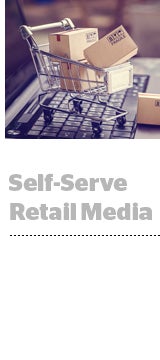Criteo on Wednesday launched a self-serve ad platform for its retail media network.
The platform connects demand from brands directly to supply from retailers across Criteo’s network, said Geoffroy Martin, EVP and GM of retail media at Criteo. Previously, brands could access Criteo’s retail media supply through a managed service. Criteo works with more than 100 of the world’s top retailers, but declined to share names.
“By opening the platform to be self-serve, we’re increasing the amount of demand that’s going to flow to retailers,” Martin said.
And for brands and agencies, having direct access to the platform lets them target more granular audiences and optimize campaigns on the fly, based on supply chain availability. Access to retail media is especially important as ecommerce surges during the pandemic.
The self-serve component also means buyers no longer have to pay managed services fees. Criteo charges on a transparent SaaS fee and percentage of media spend.
“It allows us transparency for the first time ever to see the cost of the technology vs. the share the retailers are getting,” said David Hutchinson, VP of marketplace and retailer optimization at iProspect.
Criteo’s platform also enables agencies to more granularly measure return on ad spend. Buyers using the platform can buy on a CPM or CPC, depending on campaign objectives, and receive reporting across retailer sites.
An advertiser promoting a white bean coffee, for example, can measure whether spend drove sales of that specific product, vs. a regular coffee brand in their portfolio, Hutchinson said.
“If my marketing is all about driving sales of white coffee, I need to know which ads drive those sales,” he said.
Retail media has until recently been seen as a bottom-funnel tactic sold on clicks. But brands see an opportunity to run mid- and upper-funnel campaigns on guaranteed CPMs as ecommerce surges during the pandemic.
“On one hand, you want to make sure you’re there when a consumer is taking an action,” Criteo’s Martin said. “On the other, you want to be top of mind with guaranteed placement.”
Retail media is a growth area for Criteo, which in recent years has worked to pivot away from retargeting. For instance, Criteo bought the retail ad platform HookLogic, whose clients back then included Walmart, in 2016.
Hooking directly into retailer supply lets data-poor CPGs target audiences against retailer transaction data and first-party cookies.
“It stays on that property, so it takes away a lot of the concerns with third-party cookies,” Martin said.
Since the pandemic began, Criteo has seen net new brands spend on retail media and incumbent brands increase spend as more people shop online. Retail media is attracting traditional media budgets in addition to search and trade budgets as it moves up the funnel.
And while Criteo faces steeper competition from media platforms actually owned by big box stores such as Walmart, Kroger and Target, there’s an advantage to working with a third-party instead of directly with each retailer.
“[Retailer] walled gardens have different ways of deploying placements and counting sales,” said Hutchinson. “With Criteo we know when we deploy media, it’s going to be the same across retailers and the attribution windows will be similar.”
For agencies, the biggest challenge is figuring out where to find the retail expertise within their own organization.
“Do you have it sitting with your display or search team, or do you have an ecommerce specialist unit?” Hutchinson said. “Agencies are still wrestling with how that’s positioned.”
Correction: This story previously said Criteo’s self-serve platform launched in beta. The platform has formally launched and is no longer in beta.
















